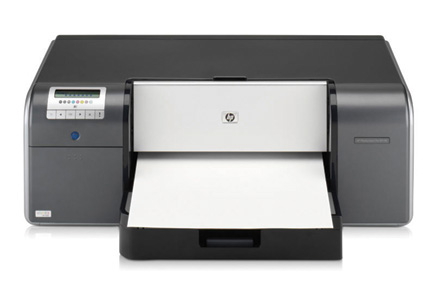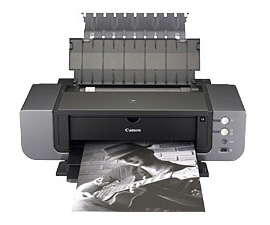The New Pigment Ink Printers: How They Change Desktop Printing
![]()
The New Pigment Ink Printers: How They Change Desktop Printing
by George Schaub
You wouldn't think that a small thing like changing the type of ink a printer uses would have a profound effect on desktop photo printing, but that's what the new products from Canon and HP might do. That change is offering pigment ink desktop printers. Epson has long been the leader in the photo/inkjet pigment printer field, starting out with the Epson 2000P, followed up by the 2200P and now their 2400 and 4800 models for the advanced amateur and pro. The new Canon and HP pigment ink printer models introduced at PMA now makes three manufacturers who have realized that pigment inks are what photo desktop printers want, and is one reason why I think that more and more photographers will be choosing pigment ink printers when making their prints at home or in the studio.

There are two types of desktop photo inkjet printers available--one type uses dye based inks while the others use pigment inks. When Epson first came out with pigment ink printers they revolutionized the desktop printing market. Why? Mainly because pigment inks prints simply last longer. It wasn't a matter of a few years--tests showed that pigment ink prints, given equal and good storage conditions, significantly outlasted dye-based ink prints. Yes, dye-based inks improved over the years and closed the gap, but in some cases dye-based ink prints had quite poor stability. Add in the "wrong' paper and some prints faded in as short as six or seven years. Having worked with numerous printers throughout the years I can certainly attest to this. Some dye ink prints, even in so-called "dark storage" (metal drawers or "archival" albums) have paled and discolored way before I thought they would, and way before they should.
But the knock on pigment inks prints was that they exhibited much less richness than dye-based inks, and for a while that was quite true. The tradeoff for less color vitality was, of course, greater stability. Pigment inks had other growing pains. In some cases, especially with monochrome prints, they would exhibit different color casts depending on the light in which they were displayed. They might also exhibit something called "gloss differential", a sort of topography of surface in certain density areas. And there might also be a "drydown" effect, familiar to those who have labored in the chemical darkroom, where a print might exhibit a certain density and even color when hot off the press, but a quite different look 24 hours later.
 But those
who understood that a print is only as good as how long it lasts stuck with
pigment. Dedicated printers worked with custom profiles, special processing
techniques (RIPs) and even elaborate workarounds to maintain the benefit of
longevity that pigment offers. Third-party ink makers, like Cone Editions, Lyson
and MediaStreet, mixed up their own inks and created workflows that in many
cases overcame some of the pigment ink faults. Now, however, pigment is becoming
mainstream, and more and more printmakers can benefit from its use.
But those
who understood that a print is only as good as how long it lasts stuck with
pigment. Dedicated printers worked with custom profiles, special processing
techniques (RIPs) and even elaborate workarounds to maintain the benefit of
longevity that pigment offers. Third-party ink makers, like Cone Editions, Lyson
and MediaStreet, mixed up their own inks and created workflows that in many
cases overcame some of the pigment ink faults. Now, however, pigment is becoming
mainstream, and more and more printmakers can benefit from its use.
The latest printers from Canon, Epson and HP offer their own brands of pigment inks, and the R&D money that these companies can bring to the table is impressive . Canon has their Pixma Pro 9500 model; Epson has their Ultrachrome K3 for their 2400 and 4800 printers; and HP has Vivera Pigment ink for their latest B9180 13 x 19 inch printer. Preliminary tests show that "100 year plus prints" should be expected from all these printers. With the right paper and storage conditions, 200 year plus prints are also possible. Contrast that with some dye-based inkjet prints that test out at less than ten years and you see why printmakers from all walks of life might now make pigment ink prints their number one choice.
Where do these test numbers come from? The main source is Wilhelm Imaging Research, headed up by Henry Wilhelm, a gadfly turned benchmark-maker. (To see test results visit www.wilhelm-research.com.) Wilhelm's numbers are relied upon, and quoted by these and other manufacturers, although it must be said that some manufacturers do regard them with a highly jaundiced eye. Seeing as there is no ISO standard for archival testing of paper/ink combinations, and that there seems to be no such agreement for standards forthcoming, many companies rely on Wilhelm for their numbers. They do not do this, it seems to me, for lack of their own internal testing by their own accomplished scientists, but more out of a desire for relying on an objective, third-party source. Should HP or Canon come out with their own numbers they might be regarded with some suspicion, but if a third party handles it I guess they all feel more comfortable about it.
I can't say why the standards have not been forthcoming. Perhaps one reason is the incredible permutations one must work out in order to arrive at any sane standard. The mix includes paper/ink combinations, lighting conditions under which the print is stored, the drydown effect and how soon the print is put away, humidity levels and more. Add in all the third party papers and inks, and the inclination of printers to experiment, and you have quite a ball of wax.
 The point
is, however, that the perception that pigment ink prints last longer is now
taking hold. Ask yourself which would you rather have--a print that lasts
ten years or one that's predicted to last 100 years, which one do you
suspect you'd choose? That holds for "fine art" printers,
those who print for the joy of seeing their work. For them it would be no contest.
But even more important would be the response of those who print to preserve
family memories. Many of us have prints from the early part of the twentieth
century in old family albums that still show the faces of our grandparents or
great-grandparents as children. Would we trust a print that fades because of
poor ink/paper stability, or spend whatever it took to keep those memories alive?
The answer is obvious.
The point
is, however, that the perception that pigment ink prints last longer is now
taking hold. Ask yourself which would you rather have--a print that lasts
ten years or one that's predicted to last 100 years, which one do you
suspect you'd choose? That holds for "fine art" printers,
those who print for the joy of seeing their work. For them it would be no contest.
But even more important would be the response of those who print to preserve
family memories. Many of us have prints from the early part of the twentieth
century in old family albums that still show the faces of our grandparents or
great-grandparents as children. Would we trust a print that fades because of
poor ink/paper stability, or spend whatever it took to keep those memories alive?
The answer is obvious.
That's why some form of testing standard that all could accept are crucial to the future of the home printing business, and why pigment ink prints will become an even more important factor in buying decisions in the future. Perhaps the general public does not have wind of the differences yet, but as a dedicated photographer you should be aware of the best way to protecting and insuring images.
Many of us have old slide and negative film--dye based images--that have undergone fading, density loss and discoloration. But others have shot on Kodachrome, still the most stable type of color film ever made. If we knew then what we know now, would we have shot on anything but Kodachrome in the past?
Yes, the tests are variable and sometimes do not reflect the real world, and after all the tests address "predictions" or the likelihood of this or that happening. Indeed, it was predicted that Polaroid film would undergo the big fade rather quickly, but I have SX70 prints shot in the mid-1980's that still have the same luxurious color as when they popped out of the camera. Are these prints anomalies, or does the exception prove the rule?
But now that pigment inks are, in a sense, going mainstream, and more and more manufacturers will be beating the longevity drum, it might be time for all concerned to sit around the table and come to some conclusions. Given the growing appreciation of the differences between pigment and dye-based inkjet prints, I believe that, given the choice, many of us will increasingly go the pigment ink route whenever we can.
- Log in or register to post comments












































